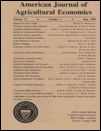Functional Form and the Statistical Properties of Welfare Measures
Abstract
This paper uses Monte Carlo analysis to compare the variance of consumer's surplus for several functional forms for demand. Although the semilog and linear forms fit the data well by statistical criteria, the coefficients of variation for consumer's surplus generated by these forms were substantially larger than for the double log and linear-log forms. While this paper is framed in the travel cost approach to recreational demand, there are implications for the choice of functional form whenever the measure of interest is a nonlinear transformation of the estimated parameters.




